Report on Social Influence: Analyzing Cultural Impact and Policy Use
VerifiedAdded on 2021/11/17
|11
|2270
|61
Report
AI Summary
This report provides a comprehensive summary, comprehension, and analysis of social influence, examining its impact on cultural trends and policy decision-making. It delves into the studies of Valente, Salganik, Dodds, and Watts, highlighting how social influence contributes to the unpredictable popularity of cultural phenomena and how policy formulators can leverage it using the theory of diffusion of information. The report discusses the roles of mass media and interpersonal influence in shaping public opinion and policy adoption, referencing examples such as the prescription of novel drugs, the adoption of hybridized corn, and the dissemination of news. It also considers the psychological factors driving social influence, such as the need for acceptance and the ease of persuasion. The analysis concludes that understanding the dynamics of social influence is crucial for sociologists and policy makers alike, paving the way for more effective strategies in predicting cultural success and implementing public programs. Desklib offers a wealth of resources, including past papers and solved assignments, to further explore these topics.

Running head: SUMMARY, COMPREHENSION AND ANALYSIS
SUMMARY, COMPREHENSION AND ANALYSIS
Name of the Student:
Name of the University:
Author note:
SUMMARY, COMPREHENSION AND ANALYSIS
Name of the Student:
Name of the University:
Author note:
Paraphrase This Document
Need a fresh take? Get an instant paraphrase of this document with our AI Paraphraser
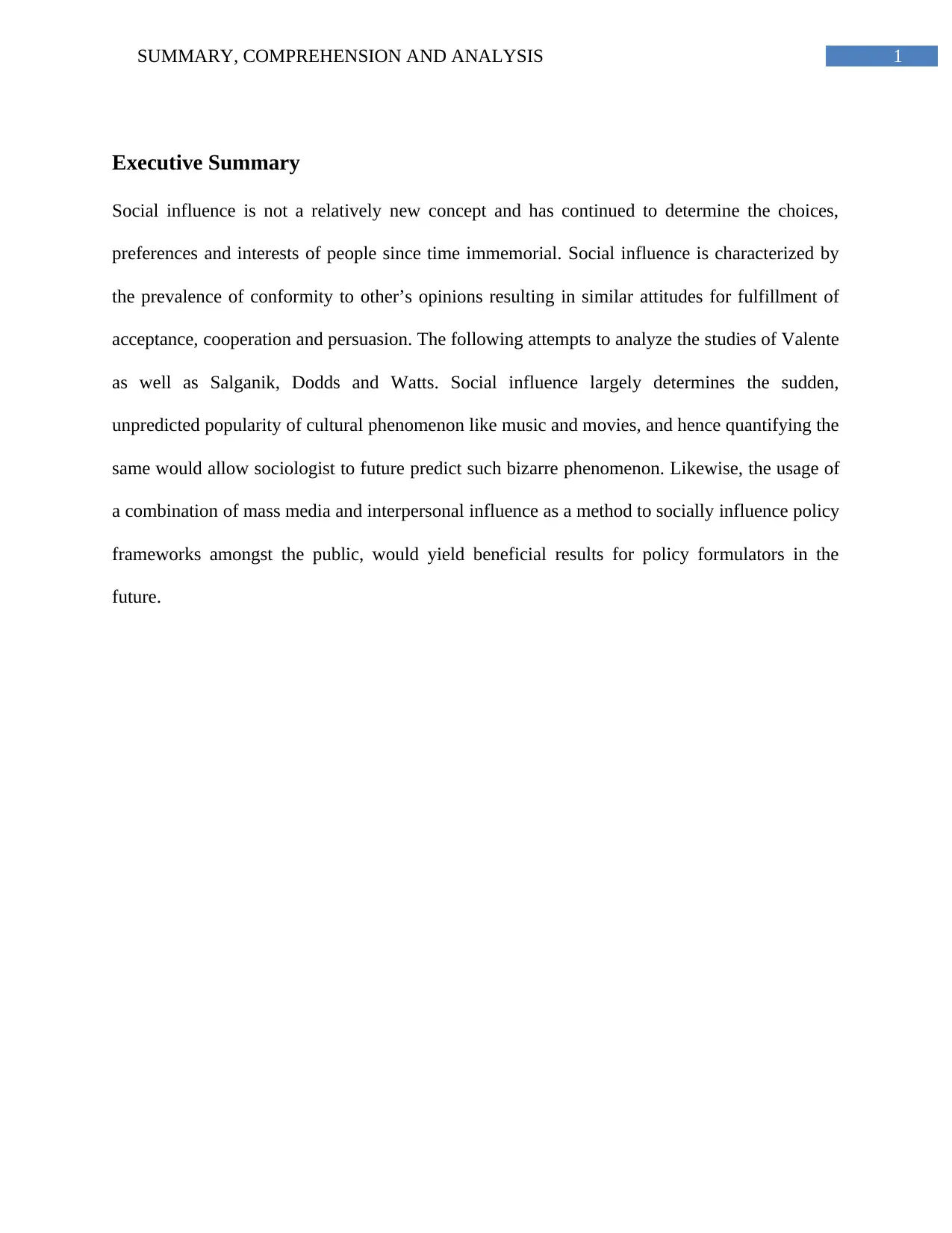
1SUMMARY, COMPREHENSION AND ANALYSIS
Executive Summary
Social influence is not a relatively new concept and has continued to determine the choices,
preferences and interests of people since time immemorial. Social influence is characterized by
the prevalence of conformity to other’s opinions resulting in similar attitudes for fulfillment of
acceptance, cooperation and persuasion. The following attempts to analyze the studies of Valente
as well as Salganik, Dodds and Watts. Social influence largely determines the sudden,
unpredicted popularity of cultural phenomenon like music and movies, and hence quantifying the
same would allow sociologist to future predict such bizarre phenomenon. Likewise, the usage of
a combination of mass media and interpersonal influence as a method to socially influence policy
frameworks amongst the public, would yield beneficial results for policy formulators in the
future.
Executive Summary
Social influence is not a relatively new concept and has continued to determine the choices,
preferences and interests of people since time immemorial. Social influence is characterized by
the prevalence of conformity to other’s opinions resulting in similar attitudes for fulfillment of
acceptance, cooperation and persuasion. The following attempts to analyze the studies of Valente
as well as Salganik, Dodds and Watts. Social influence largely determines the sudden,
unpredicted popularity of cultural phenomenon like music and movies, and hence quantifying the
same would allow sociologist to future predict such bizarre phenomenon. Likewise, the usage of
a combination of mass media and interpersonal influence as a method to socially influence policy
frameworks amongst the public, would yield beneficial results for policy formulators in the
future.
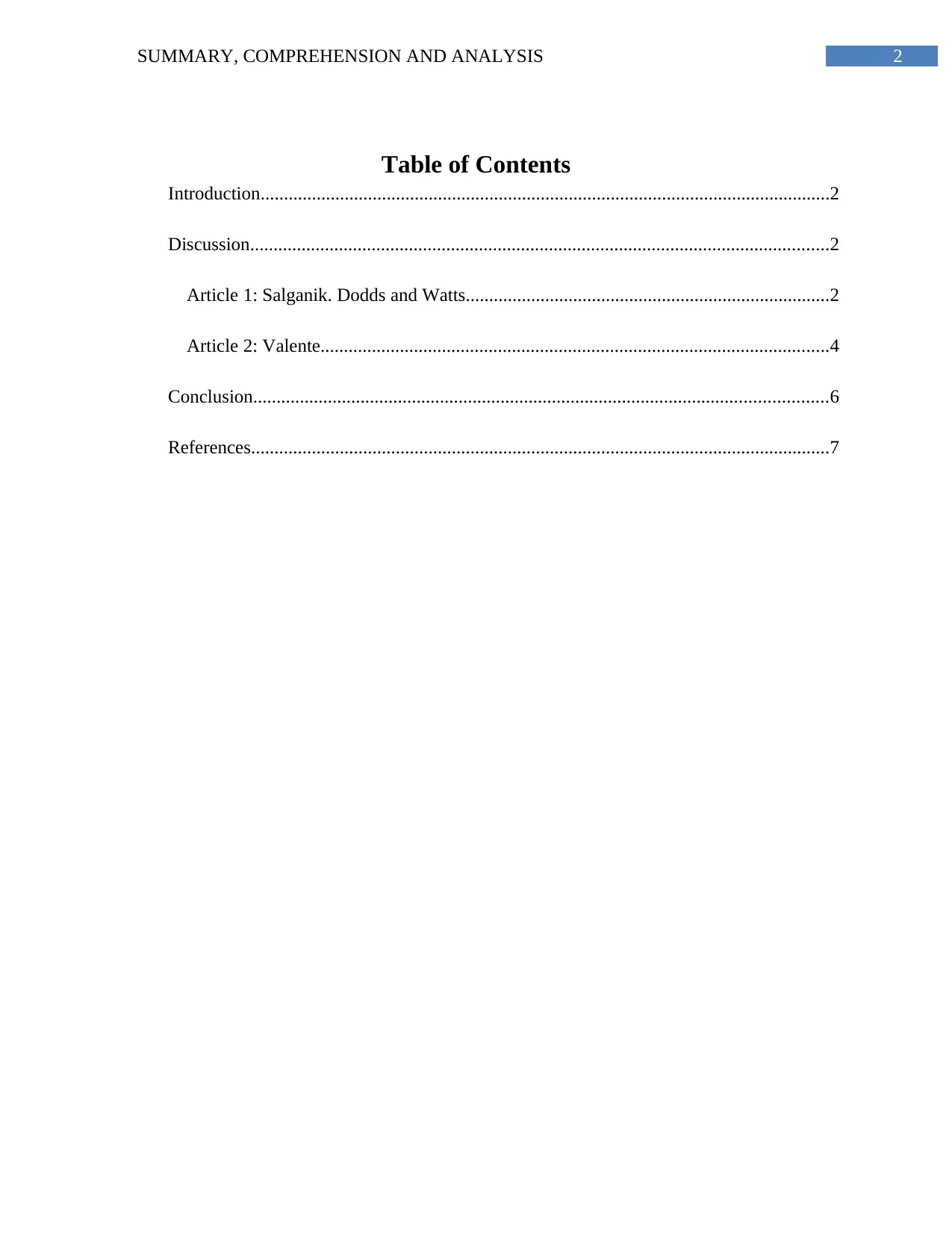
2SUMMARY, COMPREHENSION AND ANALYSIS
Table of Contents
Introduction..........................................................................................................................2
Discussion............................................................................................................................2
Article 1: Salganik. Dodds and Watts..............................................................................2
Article 2: Valente.............................................................................................................4
Conclusion...........................................................................................................................6
References............................................................................................................................7
Table of Contents
Introduction..........................................................................................................................2
Discussion............................................................................................................................2
Article 1: Salganik. Dodds and Watts..............................................................................2
Article 2: Valente.............................................................................................................4
Conclusion...........................................................................................................................6
References............................................................................................................................7
⊘ This is a preview!⊘
Do you want full access?
Subscribe today to unlock all pages.

Trusted by 1+ million students worldwide
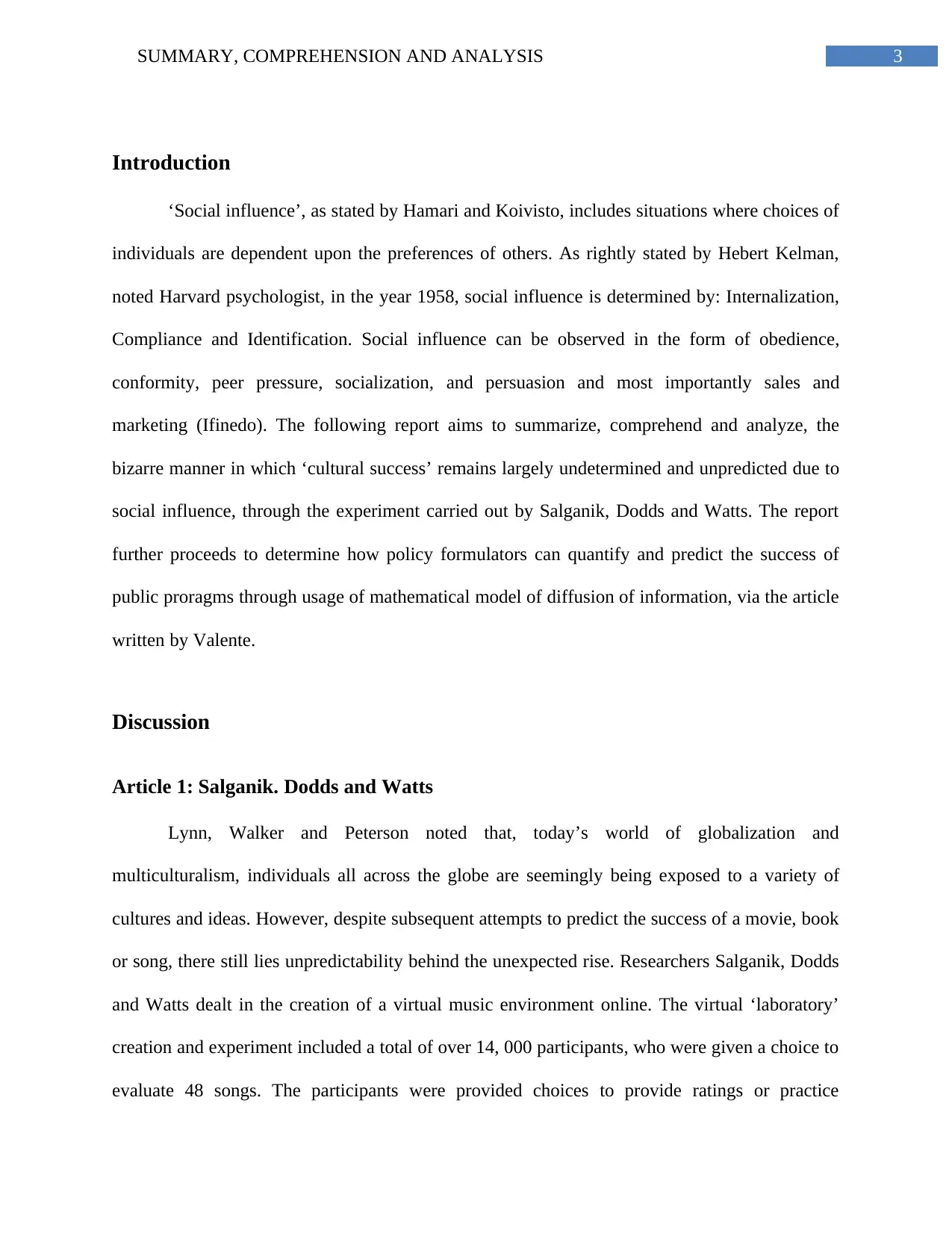
3SUMMARY, COMPREHENSION AND ANALYSIS
Introduction
‘Social influence’, as stated by Hamari and Koivisto, includes situations where choices of
individuals are dependent upon the preferences of others. As rightly stated by Hebert Kelman,
noted Harvard psychologist, in the year 1958, social influence is determined by: Internalization,
Compliance and Identification. Social influence can be observed in the form of obedience,
conformity, peer pressure, socialization, and persuasion and most importantly sales and
marketing (Ifinedo). The following report aims to summarize, comprehend and analyze, the
bizarre manner in which ‘cultural success’ remains largely undetermined and unpredicted due to
social influence, through the experiment carried out by Salganik, Dodds and Watts. The report
further proceeds to determine how policy formulators can quantify and predict the success of
public proragms through usage of mathematical model of diffusion of information, via the article
written by Valente.
Discussion
Article 1: Salganik. Dodds and Watts
Lynn, Walker and Peterson noted that, today’s world of globalization and
multiculturalism, individuals all across the globe are seemingly being exposed to a variety of
cultures and ideas. However, despite subsequent attempts to predict the success of a movie, book
or song, there still lies unpredictability behind the unexpected rise. Researchers Salganik, Dodds
and Watts dealt in the creation of a virtual music environment online. The virtual ‘laboratory’
creation and experiment included a total of over 14, 000 participants, who were given a choice to
evaluate 48 songs. The participants were provided choices to provide ratings or practice
Introduction
‘Social influence’, as stated by Hamari and Koivisto, includes situations where choices of
individuals are dependent upon the preferences of others. As rightly stated by Hebert Kelman,
noted Harvard psychologist, in the year 1958, social influence is determined by: Internalization,
Compliance and Identification. Social influence can be observed in the form of obedience,
conformity, peer pressure, socialization, and persuasion and most importantly sales and
marketing (Ifinedo). The following report aims to summarize, comprehend and analyze, the
bizarre manner in which ‘cultural success’ remains largely undetermined and unpredicted due to
social influence, through the experiment carried out by Salganik, Dodds and Watts. The report
further proceeds to determine how policy formulators can quantify and predict the success of
public proragms through usage of mathematical model of diffusion of information, via the article
written by Valente.
Discussion
Article 1: Salganik. Dodds and Watts
Lynn, Walker and Peterson noted that, today’s world of globalization and
multiculturalism, individuals all across the globe are seemingly being exposed to a variety of
cultures and ideas. However, despite subsequent attempts to predict the success of a movie, book
or song, there still lies unpredictability behind the unexpected rise. Researchers Salganik, Dodds
and Watts dealt in the creation of a virtual music environment online. The virtual ‘laboratory’
creation and experiment included a total of over 14, 000 participants, who were given a choice to
evaluate 48 songs. The participants were provided choices to provide ratings or practice
Paraphrase This Document
Need a fresh take? Get an instant paraphrase of this document with our AI Paraphraser
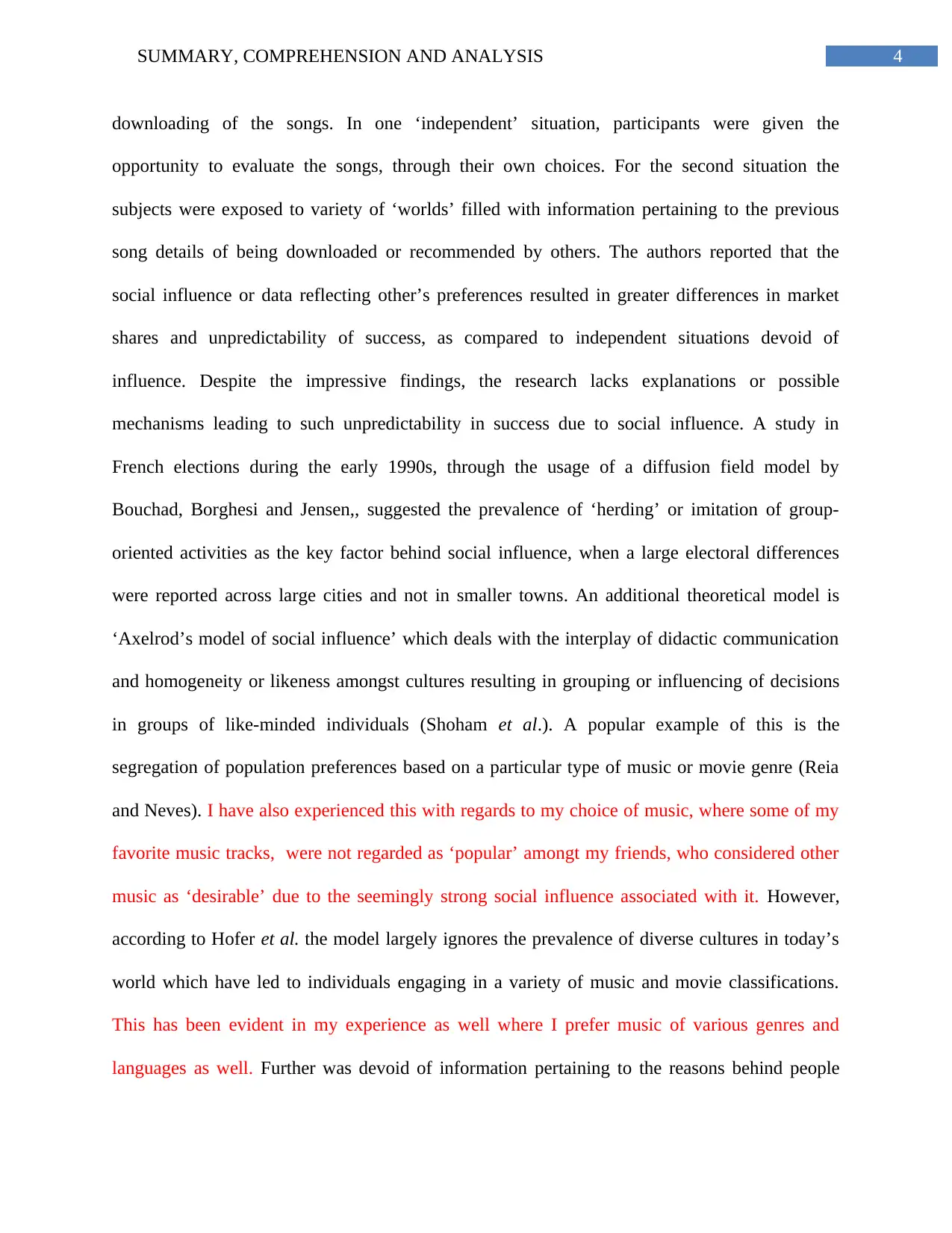
4SUMMARY, COMPREHENSION AND ANALYSIS
downloading of the songs. In one ‘independent’ situation, participants were given the
opportunity to evaluate the songs, through their own choices. For the second situation the
subjects were exposed to variety of ‘worlds’ filled with information pertaining to the previous
song details of being downloaded or recommended by others. The authors reported that the
social influence or data reflecting other’s preferences resulted in greater differences in market
shares and unpredictability of success, as compared to independent situations devoid of
influence. Despite the impressive findings, the research lacks explanations or possible
mechanisms leading to such unpredictability in success due to social influence. A study in
French elections during the early 1990s, through the usage of a diffusion field model by
Bouchad, Borghesi and Jensen,, suggested the prevalence of ‘herding’ or imitation of group-
oriented activities as the key factor behind social influence, when a large electoral differences
were reported across large cities and not in smaller towns. An additional theoretical model is
‘Axelrod’s model of social influence’ which deals with the interplay of didactic communication
and homogeneity or likeness amongst cultures resulting in grouping or influencing of decisions
in groups of like-minded individuals (Shoham et al.). A popular example of this is the
segregation of population preferences based on a particular type of music or movie genre (Reia
and Neves). I have also experienced this with regards to my choice of music, where some of my
favorite music tracks, were not regarded as ‘popular’ amongt my friends, who considered other
music as ‘desirable’ due to the seemingly strong social influence associated with it. However,
according to Hofer et al. the model largely ignores the prevalence of diverse cultures in today’s
world which have led to individuals engaging in a variety of music and movie classifications.
This has been evident in my experience as well where I prefer music of various genres and
languages as well. Further was devoid of information pertaining to the reasons behind people
downloading of the songs. In one ‘independent’ situation, participants were given the
opportunity to evaluate the songs, through their own choices. For the second situation the
subjects were exposed to variety of ‘worlds’ filled with information pertaining to the previous
song details of being downloaded or recommended by others. The authors reported that the
social influence or data reflecting other’s preferences resulted in greater differences in market
shares and unpredictability of success, as compared to independent situations devoid of
influence. Despite the impressive findings, the research lacks explanations or possible
mechanisms leading to such unpredictability in success due to social influence. A study in
French elections during the early 1990s, through the usage of a diffusion field model by
Bouchad, Borghesi and Jensen,, suggested the prevalence of ‘herding’ or imitation of group-
oriented activities as the key factor behind social influence, when a large electoral differences
were reported across large cities and not in smaller towns. An additional theoretical model is
‘Axelrod’s model of social influence’ which deals with the interplay of didactic communication
and homogeneity or likeness amongst cultures resulting in grouping or influencing of decisions
in groups of like-minded individuals (Shoham et al.). A popular example of this is the
segregation of population preferences based on a particular type of music or movie genre (Reia
and Neves). I have also experienced this with regards to my choice of music, where some of my
favorite music tracks, were not regarded as ‘popular’ amongt my friends, who considered other
music as ‘desirable’ due to the seemingly strong social influence associated with it. However,
according to Hofer et al. the model largely ignores the prevalence of diverse cultures in today’s
world which have led to individuals engaging in a variety of music and movie classifications.
This has been evident in my experience as well where I prefer music of various genres and
languages as well. Further was devoid of information pertaining to the reasons behind people
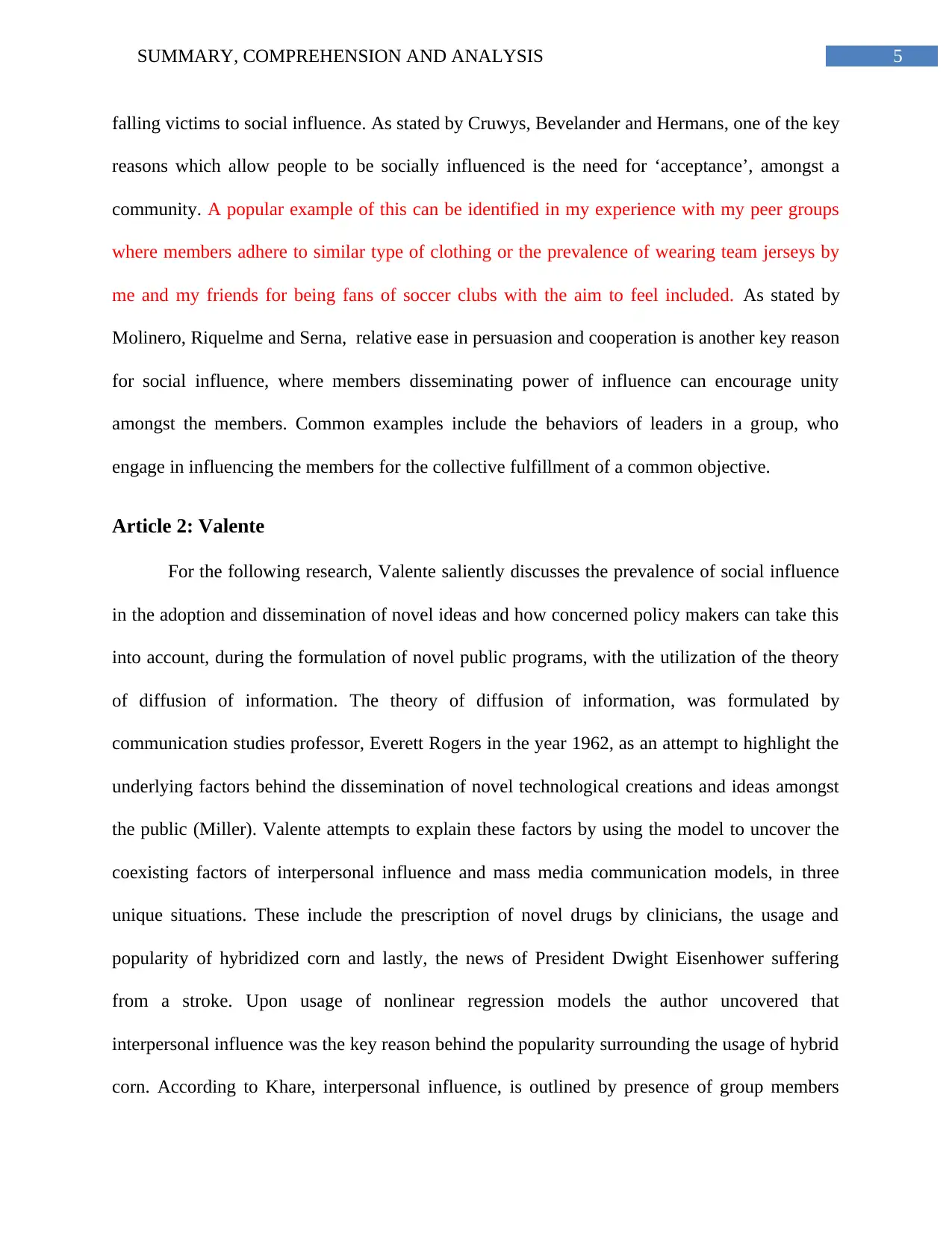
5SUMMARY, COMPREHENSION AND ANALYSIS
falling victims to social influence. As stated by Cruwys, Bevelander and Hermans, one of the key
reasons which allow people to be socially influenced is the need for ‘acceptance’, amongst a
community. A popular example of this can be identified in my experience with my peer groups
where members adhere to similar type of clothing or the prevalence of wearing team jerseys by
me and my friends for being fans of soccer clubs with the aim to feel included. As stated by
Molinero, Riquelme and Serna, relative ease in persuasion and cooperation is another key reason
for social influence, where members disseminating power of influence can encourage unity
amongst the members. Common examples include the behaviors of leaders in a group, who
engage in influencing the members for the collective fulfillment of a common objective.
Article 2: Valente
For the following research, Valente saliently discusses the prevalence of social influence
in the adoption and dissemination of novel ideas and how concerned policy makers can take this
into account, during the formulation of novel public programs, with the utilization of the theory
of diffusion of information. The theory of diffusion of information, was formulated by
communication studies professor, Everett Rogers in the year 1962, as an attempt to highlight the
underlying factors behind the dissemination of novel technological creations and ideas amongst
the public (Miller). Valente attempts to explain these factors by using the model to uncover the
coexisting factors of interpersonal influence and mass media communication models, in three
unique situations. These include the prescription of novel drugs by clinicians, the usage and
popularity of hybridized corn and lastly, the news of President Dwight Eisenhower suffering
from a stroke. Upon usage of nonlinear regression models the author uncovered that
interpersonal influence was the key reason behind the popularity surrounding the usage of hybrid
corn. According to Khare, interpersonal influence, is outlined by presence of group members
falling victims to social influence. As stated by Cruwys, Bevelander and Hermans, one of the key
reasons which allow people to be socially influenced is the need for ‘acceptance’, amongst a
community. A popular example of this can be identified in my experience with my peer groups
where members adhere to similar type of clothing or the prevalence of wearing team jerseys by
me and my friends for being fans of soccer clubs with the aim to feel included. As stated by
Molinero, Riquelme and Serna, relative ease in persuasion and cooperation is another key reason
for social influence, where members disseminating power of influence can encourage unity
amongst the members. Common examples include the behaviors of leaders in a group, who
engage in influencing the members for the collective fulfillment of a common objective.
Article 2: Valente
For the following research, Valente saliently discusses the prevalence of social influence
in the adoption and dissemination of novel ideas and how concerned policy makers can take this
into account, during the formulation of novel public programs, with the utilization of the theory
of diffusion of information. The theory of diffusion of information, was formulated by
communication studies professor, Everett Rogers in the year 1962, as an attempt to highlight the
underlying factors behind the dissemination of novel technological creations and ideas amongst
the public (Miller). Valente attempts to explain these factors by using the model to uncover the
coexisting factors of interpersonal influence and mass media communication models, in three
unique situations. These include the prescription of novel drugs by clinicians, the usage and
popularity of hybridized corn and lastly, the news of President Dwight Eisenhower suffering
from a stroke. Upon usage of nonlinear regression models the author uncovered that
interpersonal influence was the key reason behind the popularity surrounding the usage of hybrid
corn. According to Khare, interpersonal influence, is outlined by presence of group members
⊘ This is a preview!⊘
Do you want full access?
Subscribe today to unlock all pages.

Trusted by 1+ million students worldwide
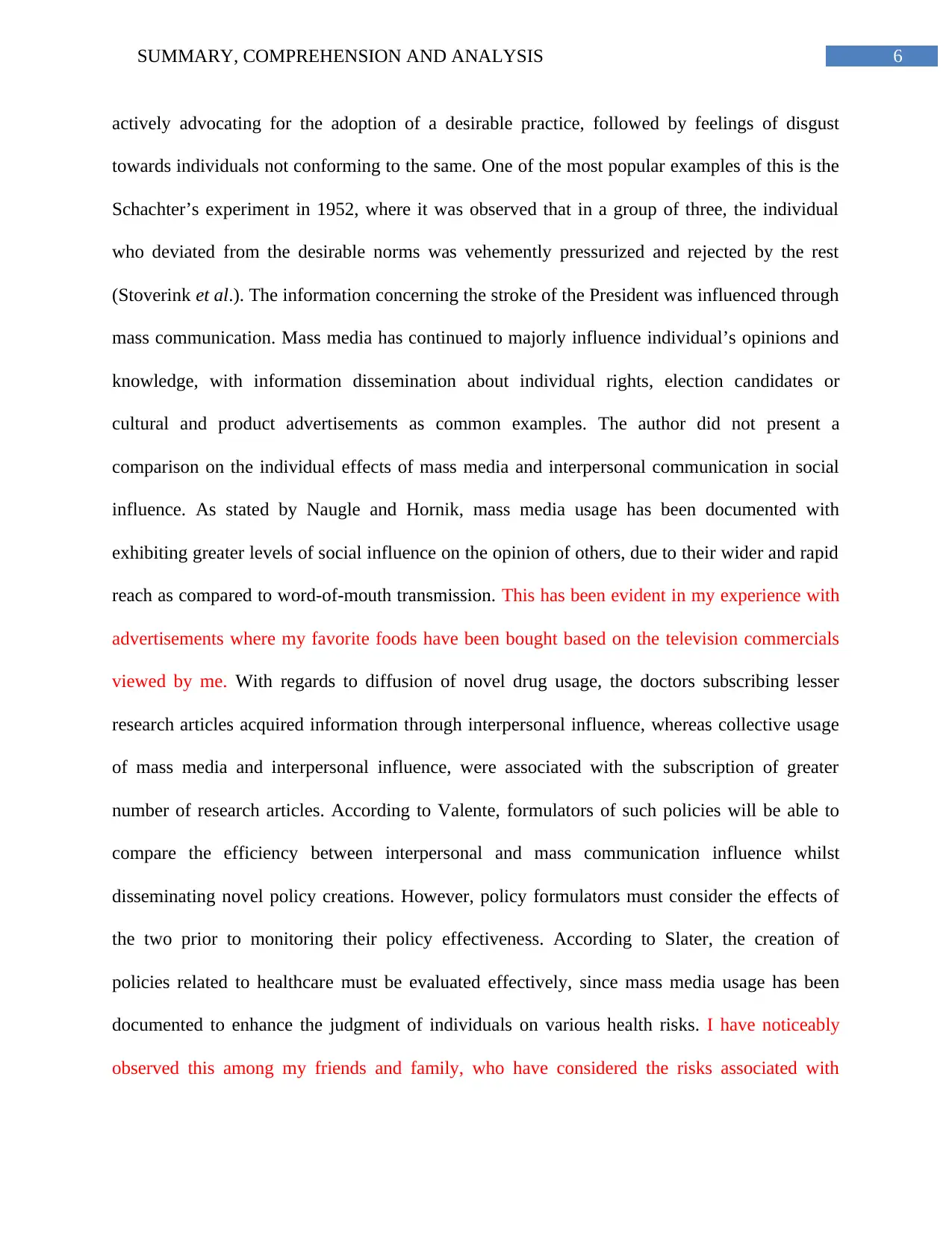
6SUMMARY, COMPREHENSION AND ANALYSIS
actively advocating for the adoption of a desirable practice, followed by feelings of disgust
towards individuals not conforming to the same. One of the most popular examples of this is the
Schachter’s experiment in 1952, where it was observed that in a group of three, the individual
who deviated from the desirable norms was vehemently pressurized and rejected by the rest
(Stoverink et al.). The information concerning the stroke of the President was influenced through
mass communication. Mass media has continued to majorly influence individual’s opinions and
knowledge, with information dissemination about individual rights, election candidates or
cultural and product advertisements as common examples. The author did not present a
comparison on the individual effects of mass media and interpersonal communication in social
influence. As stated by Naugle and Hornik, mass media usage has been documented with
exhibiting greater levels of social influence on the opinion of others, due to their wider and rapid
reach as compared to word-of-mouth transmission. This has been evident in my experience with
advertisements where my favorite foods have been bought based on the television commercials
viewed by me. With regards to diffusion of novel drug usage, the doctors subscribing lesser
research articles acquired information through interpersonal influence, whereas collective usage
of mass media and interpersonal influence, were associated with the subscription of greater
number of research articles. According to Valente, formulators of such policies will be able to
compare the efficiency between interpersonal and mass communication influence whilst
disseminating novel policy creations. However, policy formulators must consider the effects of
the two prior to monitoring their policy effectiveness. According to Slater, the creation of
policies related to healthcare must be evaluated effectively, since mass media usage has been
documented to enhance the judgment of individuals on various health risks. I have noticeably
observed this among my friends and family, who have considered the risks associated with
actively advocating for the adoption of a desirable practice, followed by feelings of disgust
towards individuals not conforming to the same. One of the most popular examples of this is the
Schachter’s experiment in 1952, where it was observed that in a group of three, the individual
who deviated from the desirable norms was vehemently pressurized and rejected by the rest
(Stoverink et al.). The information concerning the stroke of the President was influenced through
mass communication. Mass media has continued to majorly influence individual’s opinions and
knowledge, with information dissemination about individual rights, election candidates or
cultural and product advertisements as common examples. The author did not present a
comparison on the individual effects of mass media and interpersonal communication in social
influence. As stated by Naugle and Hornik, mass media usage has been documented with
exhibiting greater levels of social influence on the opinion of others, due to their wider and rapid
reach as compared to word-of-mouth transmission. This has been evident in my experience with
advertisements where my favorite foods have been bought based on the television commercials
viewed by me. With regards to diffusion of novel drug usage, the doctors subscribing lesser
research articles acquired information through interpersonal influence, whereas collective usage
of mass media and interpersonal influence, were associated with the subscription of greater
number of research articles. According to Valente, formulators of such policies will be able to
compare the efficiency between interpersonal and mass communication influence whilst
disseminating novel policy creations. However, policy formulators must consider the effects of
the two prior to monitoring their policy effectiveness. According to Slater, the creation of
policies related to healthcare must be evaluated effectively, since mass media usage has been
documented to enhance the judgment of individuals on various health risks. I have noticeably
observed this among my friends and family, who have considered the risks associated with
Paraphrase This Document
Need a fresh take? Get an instant paraphrase of this document with our AI Paraphraser
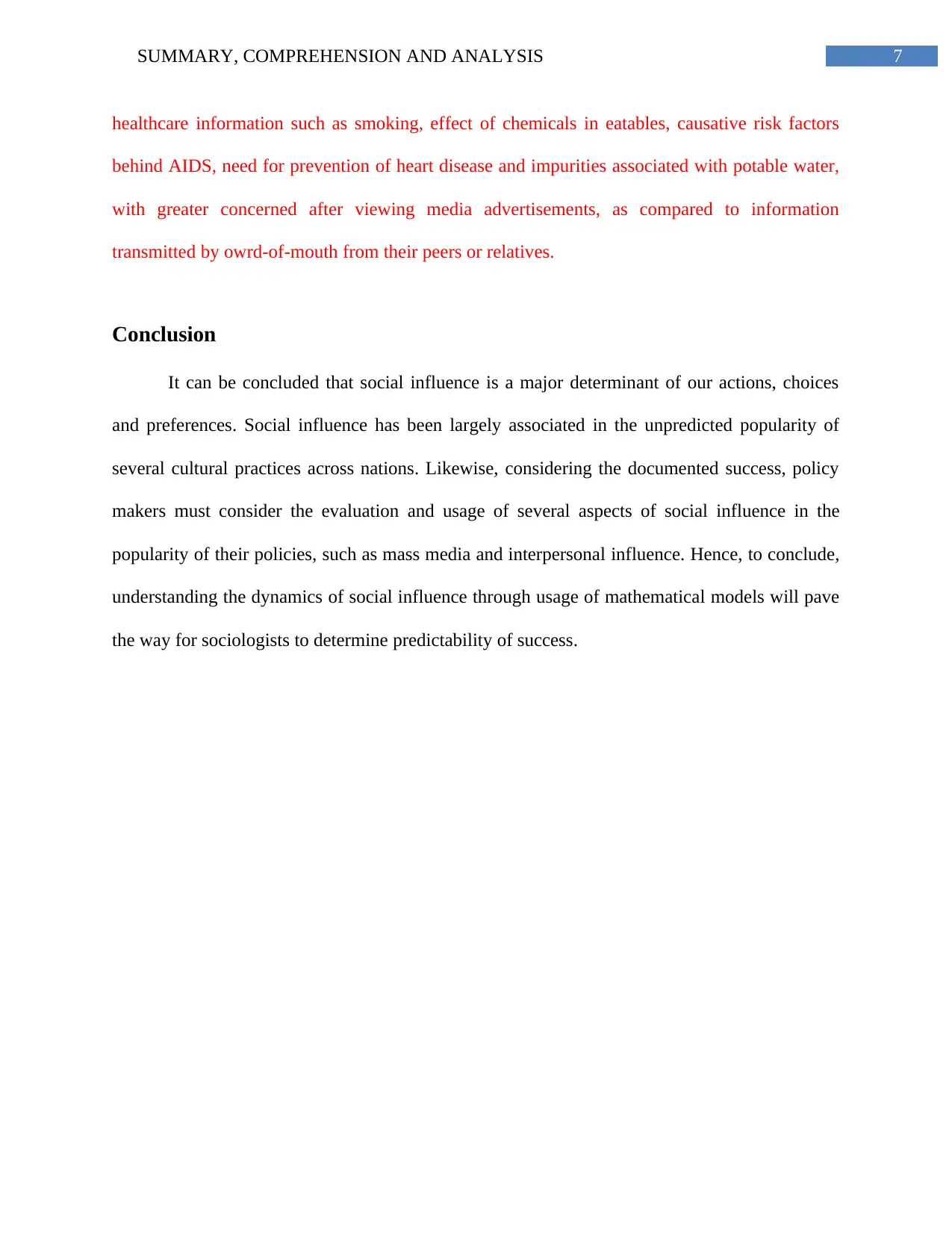
7SUMMARY, COMPREHENSION AND ANALYSIS
healthcare information such as smoking, effect of chemicals in eatables, causative risk factors
behind AIDS, need for prevention of heart disease and impurities associated with potable water,
with greater concerned after viewing media advertisements, as compared to information
transmitted by owrd-of-mouth from their peers or relatives.
Conclusion
It can be concluded that social influence is a major determinant of our actions, choices
and preferences. Social influence has been largely associated in the unpredicted popularity of
several cultural practices across nations. Likewise, considering the documented success, policy
makers must consider the evaluation and usage of several aspects of social influence in the
popularity of their policies, such as mass media and interpersonal influence. Hence, to conclude,
understanding the dynamics of social influence through usage of mathematical models will pave
the way for sociologists to determine predictability of success.
healthcare information such as smoking, effect of chemicals in eatables, causative risk factors
behind AIDS, need for prevention of heart disease and impurities associated with potable water,
with greater concerned after viewing media advertisements, as compared to information
transmitted by owrd-of-mouth from their peers or relatives.
Conclusion
It can be concluded that social influence is a major determinant of our actions, choices
and preferences. Social influence has been largely associated in the unpredicted popularity of
several cultural practices across nations. Likewise, considering the documented success, policy
makers must consider the evaluation and usage of several aspects of social influence in the
popularity of their policies, such as mass media and interpersonal influence. Hence, to conclude,
understanding the dynamics of social influence through usage of mathematical models will pave
the way for sociologists to determine predictability of success.
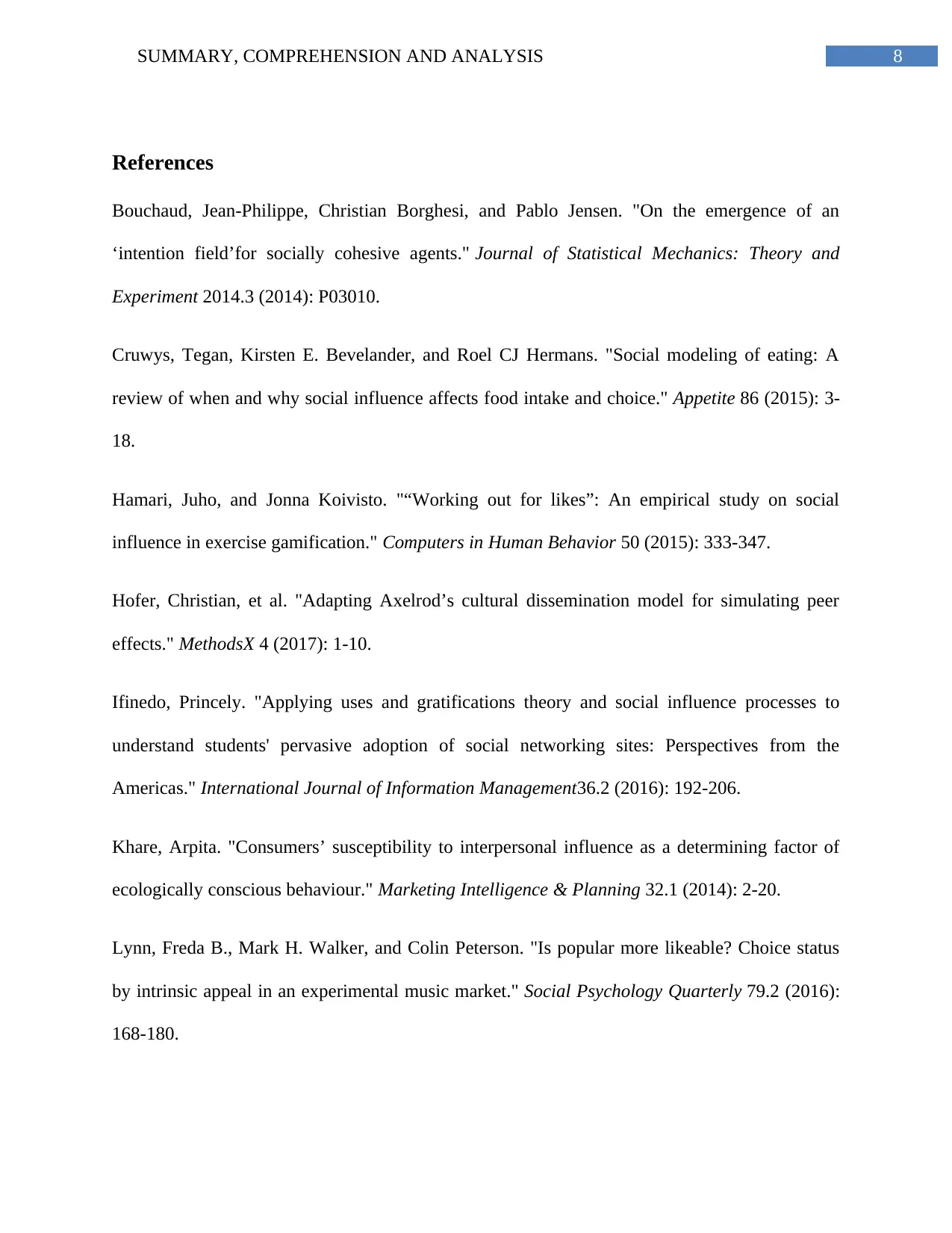
8SUMMARY, COMPREHENSION AND ANALYSIS
References
Bouchaud, Jean-Philippe, Christian Borghesi, and Pablo Jensen. "On the emergence of an
‘intention field’for socially cohesive agents." Journal of Statistical Mechanics: Theory and
Experiment 2014.3 (2014): P03010.
Cruwys, Tegan, Kirsten E. Bevelander, and Roel CJ Hermans. "Social modeling of eating: A
review of when and why social influence affects food intake and choice." Appetite 86 (2015): 3-
18.
Hamari, Juho, and Jonna Koivisto. "“Working out for likes”: An empirical study on social
influence in exercise gamification." Computers in Human Behavior 50 (2015): 333-347.
Hofer, Christian, et al. "Adapting Axelrod’s cultural dissemination model for simulating peer
effects." MethodsX 4 (2017): 1-10.
Ifinedo, Princely. "Applying uses and gratifications theory and social influence processes to
understand students' pervasive adoption of social networking sites: Perspectives from the
Americas." International Journal of Information Management36.2 (2016): 192-206.
Khare, Arpita. "Consumers’ susceptibility to interpersonal influence as a determining factor of
ecologically conscious behaviour." Marketing Intelligence & Planning 32.1 (2014): 2-20.
Lynn, Freda B., Mark H. Walker, and Colin Peterson. "Is popular more likeable? Choice status
by intrinsic appeal in an experimental music market." Social Psychology Quarterly 79.2 (2016):
168-180.
References
Bouchaud, Jean-Philippe, Christian Borghesi, and Pablo Jensen. "On the emergence of an
‘intention field’for socially cohesive agents." Journal of Statistical Mechanics: Theory and
Experiment 2014.3 (2014): P03010.
Cruwys, Tegan, Kirsten E. Bevelander, and Roel CJ Hermans. "Social modeling of eating: A
review of when and why social influence affects food intake and choice." Appetite 86 (2015): 3-
18.
Hamari, Juho, and Jonna Koivisto. "“Working out for likes”: An empirical study on social
influence in exercise gamification." Computers in Human Behavior 50 (2015): 333-347.
Hofer, Christian, et al. "Adapting Axelrod’s cultural dissemination model for simulating peer
effects." MethodsX 4 (2017): 1-10.
Ifinedo, Princely. "Applying uses and gratifications theory and social influence processes to
understand students' pervasive adoption of social networking sites: Perspectives from the
Americas." International Journal of Information Management36.2 (2016): 192-206.
Khare, Arpita. "Consumers’ susceptibility to interpersonal influence as a determining factor of
ecologically conscious behaviour." Marketing Intelligence & Planning 32.1 (2014): 2-20.
Lynn, Freda B., Mark H. Walker, and Colin Peterson. "Is popular more likeable? Choice status
by intrinsic appeal in an experimental music market." Social Psychology Quarterly 79.2 (2016):
168-180.
⊘ This is a preview!⊘
Do you want full access?
Subscribe today to unlock all pages.

Trusted by 1+ million students worldwide
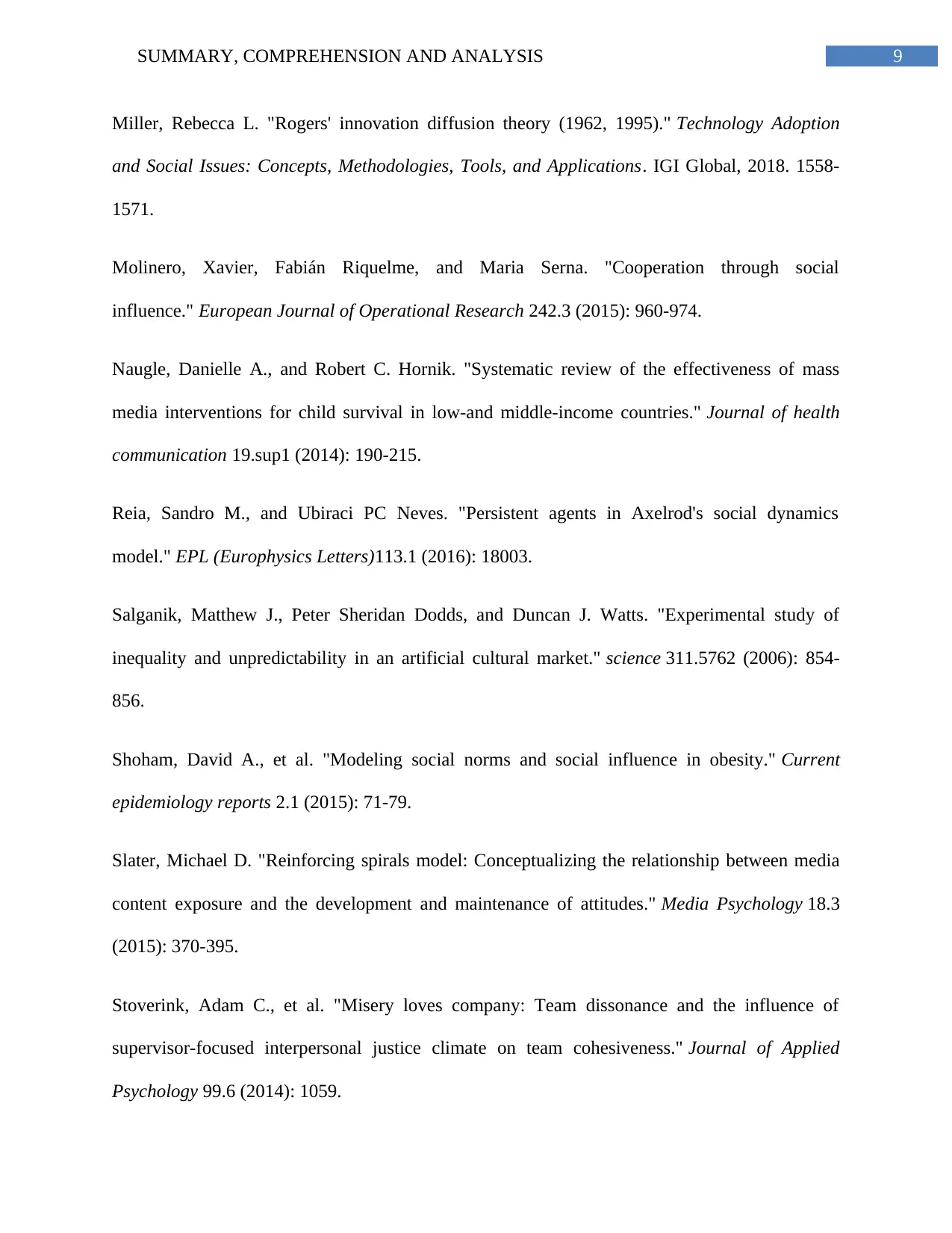
9SUMMARY, COMPREHENSION AND ANALYSIS
Miller, Rebecca L. "Rogers' innovation diffusion theory (1962, 1995)." Technology Adoption
and Social Issues: Concepts, Methodologies, Tools, and Applications. IGI Global, 2018. 1558-
1571.
Molinero, Xavier, Fabián Riquelme, and Maria Serna. "Cooperation through social
influence." European Journal of Operational Research 242.3 (2015): 960-974.
Naugle, Danielle A., and Robert C. Hornik. "Systematic review of the effectiveness of mass
media interventions for child survival in low-and middle-income countries." Journal of health
communication 19.sup1 (2014): 190-215.
Reia, Sandro M., and Ubiraci PC Neves. "Persistent agents in Axelrod's social dynamics
model." EPL (Europhysics Letters)113.1 (2016): 18003.
Salganik, Matthew J., Peter Sheridan Dodds, and Duncan J. Watts. "Experimental study of
inequality and unpredictability in an artificial cultural market." science 311.5762 (2006): 854-
856.
Shoham, David A., et al. "Modeling social norms and social influence in obesity." Current
epidemiology reports 2.1 (2015): 71-79.
Slater, Michael D. "Reinforcing spirals model: Conceptualizing the relationship between media
content exposure and the development and maintenance of attitudes." Media Psychology 18.3
(2015): 370-395.
Stoverink, Adam C., et al. "Misery loves company: Team dissonance and the influence of
supervisor-focused interpersonal justice climate on team cohesiveness." Journal of Applied
Psychology 99.6 (2014): 1059.
Miller, Rebecca L. "Rogers' innovation diffusion theory (1962, 1995)." Technology Adoption
and Social Issues: Concepts, Methodologies, Tools, and Applications. IGI Global, 2018. 1558-
1571.
Molinero, Xavier, Fabián Riquelme, and Maria Serna. "Cooperation through social
influence." European Journal of Operational Research 242.3 (2015): 960-974.
Naugle, Danielle A., and Robert C. Hornik. "Systematic review of the effectiveness of mass
media interventions for child survival in low-and middle-income countries." Journal of health
communication 19.sup1 (2014): 190-215.
Reia, Sandro M., and Ubiraci PC Neves. "Persistent agents in Axelrod's social dynamics
model." EPL (Europhysics Letters)113.1 (2016): 18003.
Salganik, Matthew J., Peter Sheridan Dodds, and Duncan J. Watts. "Experimental study of
inequality and unpredictability in an artificial cultural market." science 311.5762 (2006): 854-
856.
Shoham, David A., et al. "Modeling social norms and social influence in obesity." Current
epidemiology reports 2.1 (2015): 71-79.
Slater, Michael D. "Reinforcing spirals model: Conceptualizing the relationship between media
content exposure and the development and maintenance of attitudes." Media Psychology 18.3
(2015): 370-395.
Stoverink, Adam C., et al. "Misery loves company: Team dissonance and the influence of
supervisor-focused interpersonal justice climate on team cohesiveness." Journal of Applied
Psychology 99.6 (2014): 1059.
Paraphrase This Document
Need a fresh take? Get an instant paraphrase of this document with our AI Paraphraser
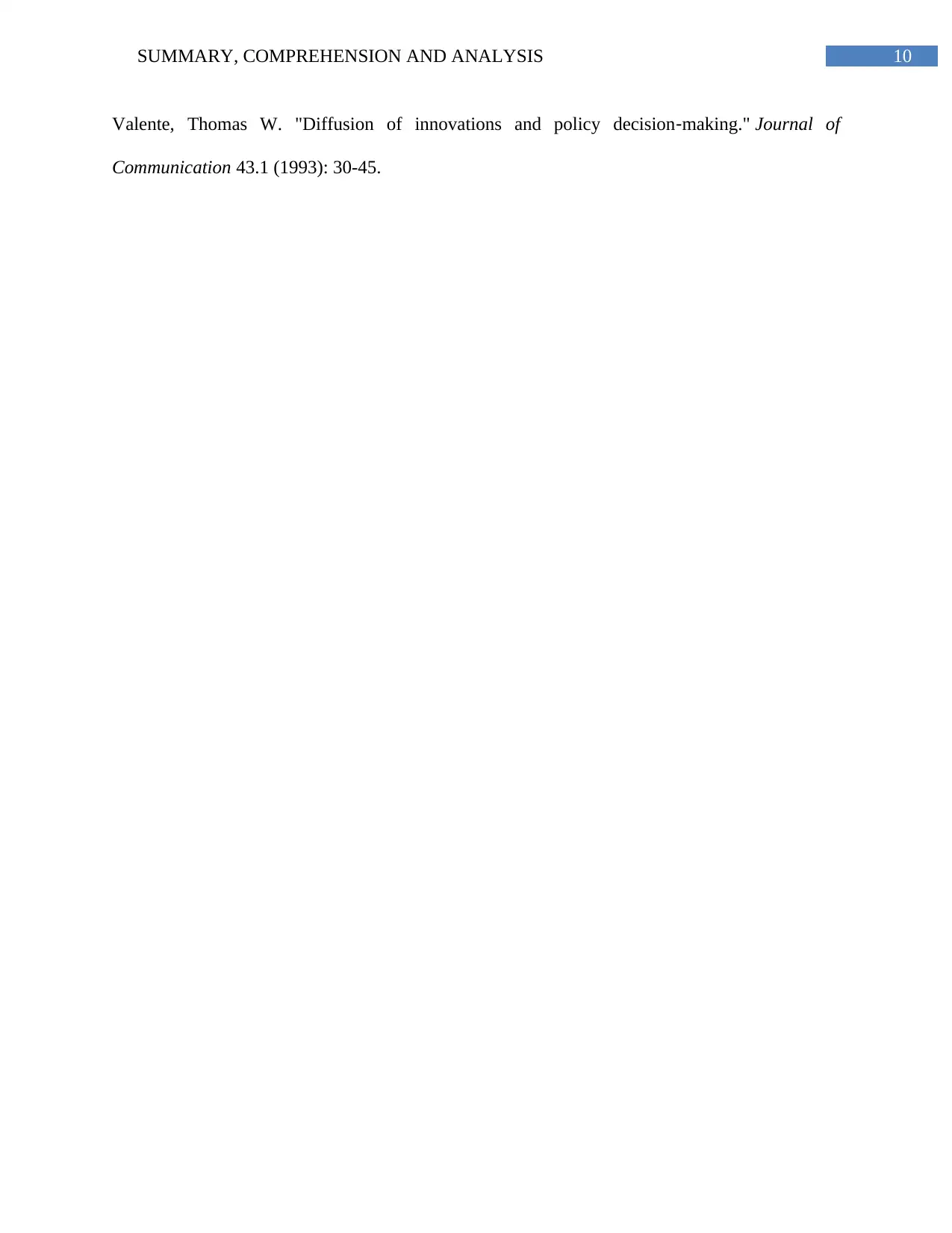
10SUMMARY, COMPREHENSION AND ANALYSIS
Valente, Thomas W. "Diffusion of innovations and policy decision‐making." Journal of
Communication 43.1 (1993): 30-45.
Valente, Thomas W. "Diffusion of innovations and policy decision‐making." Journal of
Communication 43.1 (1993): 30-45.
1 out of 11
Your All-in-One AI-Powered Toolkit for Academic Success.
+13062052269
info@desklib.com
Available 24*7 on WhatsApp / Email
![[object Object]](/_next/static/media/star-bottom.7253800d.svg)
Unlock your academic potential
Copyright © 2020–2025 A2Z Services. All Rights Reserved. Developed and managed by ZUCOL.